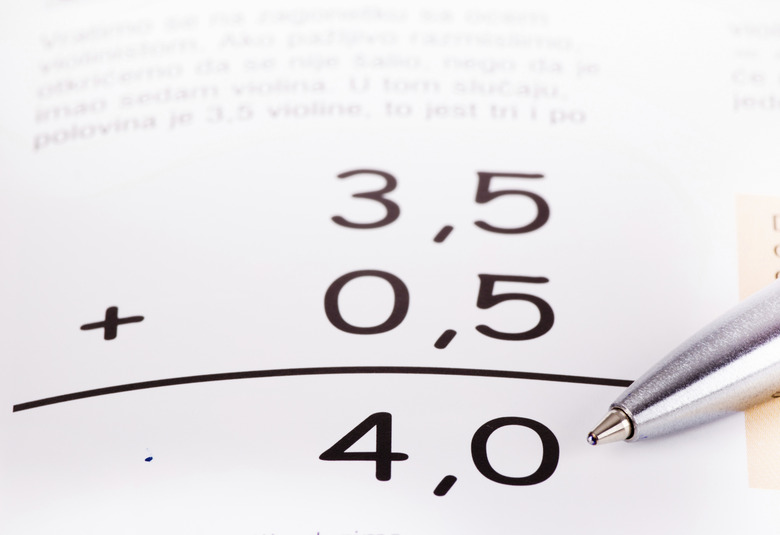How To Read Decimal Place Value
As you progress through the different levels of math, you'll be asked to work with more complicated numbers and increasingly complex operations. The more attention you pay to fundamental skills now, the easier those other tasks will be. And one of the most important building blocks of working with numbers – any numbers – is learning to read decimal place values.
What Are Decimals?
What Are Decimals?
You could make the case that technically, every number you're used to dealing with is a decimal, because it's based on the ten-digit system (numbers 0 through 9 or, if you really want to get fancy, "base ten"). But when people refer to decimals, they usually mean the numbers that go to the right of the decimal point.
Understanding Place Values
Understanding Place Values
Before going on, it helps to remember that every "slot" you can put a number in to the left of the decimal point has a specific value applied to it. Also, recall that if there's nothing to the right of the decimal point, you usually don't write the decimal point at all – but it's understood to be there all the time, just in case you need it.
So, what are the "slots" called to the left of the decimal point? Starting from the decimal point and working left, the first slot is called the ones place. However, take note! The place value applies to the "slot" the number goes in, not the number itself. So it keeps the same name, no matter what number is in that place. Whether you say 1, 2, 5, 9, or any other single-digit number, they all occupy the same "slot": the ones place. The next place to the left is the tens place. To the left of that is the hundreds place, and so on.
Have you noticed the pattern? The first place value is
\(1 = 10^0\)
and each place value to the left of it adds another power of ten. So the next place value, tens, is
\(10 = 10^1\)
after that is hundreds or
\(100 = 10^2\)
then thousands and
\(1000 = 10^3\)
and so on.
The Decimal Place Values
The Decimal Place Values
So, what about the numbers to the right of the decimal point – the decimal place values? See if you can spot the pattern as you read the name of each slot the "1" appears in:
- 0.1 = tenths slot
- 0.01 = hundredths slot
- 0.001 = thousandths slot
- 0.0001 = ten thousandths slot
Did you spot the pattern? Once again, you're dealing with powers of ten. But because everything to the right of the decimal point is less than one, the exponents are all negative. Take another look at the same decimal place values, this time with the exponents added:
\(0.1 = \text{ tenths slot} = 10^{-1} \
0.01 = \text{ hundredths slot} = 10^{-2} \
0.001 = \text{ thousandths slot} = 10^{-3} \
0.0001 = \text{ ten thousandths slot} = 10^{-4}\)
And the pattern continues for as many slots or places as you need.
TL;DR (Too Long; Didn't Read)
Again, remember that the _place value_ remains the same, no matter which _number value_ is in that place. So for 0.008, 0.005, 0.002 and 0.004, the non-zero digits are all in the thousandths place. And for 0.1, 0.2, 0.9 and 0.8 the non-zero digits are all in the tenths place value.
What Decimal Place Value Is That?
What Decimal Place Value Is That?
Practice your new-found skill by identifying which decimal place the non-zero number is in.
**Example 1:** 0.005
**Answer 1:** The 5 is in the thousandths decimal place.
**Example 2:** 0.9
**Answer 2:** The 9 is in the tenths place.
**Example 3:** 0.00004
**Answer 3:** The 4 is in the hundred-thousandths place.
How to Read Decimals
How to Read Decimals
There are two ways to read decimal numbers. The first is to simply read the digits off. In that case, 4.1 would be "four point one," 5.6 would be "five point six," and so on.
Your other option is to read off the numbers to the right of the decimal point as if they were a single integer, along with the rightmost place value you use. For example, 9.2 would be "nine and two tenths," 8.34 would be "eight and thirty four hundredths," and 9.235 would be "nine and two hundred thirty five thousandths."
Cite This Article
MLA
Maloney, Lisa. "How To Read Decimal Place Value" sciencing.com, https://www.sciencing.com/read-decimal-place-value-7533635/. 19 December 2020.
APA
Maloney, Lisa. (2020, December 19). How To Read Decimal Place Value. sciencing.com. Retrieved from https://www.sciencing.com/read-decimal-place-value-7533635/
Chicago
Maloney, Lisa. How To Read Decimal Place Value last modified March 24, 2022. https://www.sciencing.com/read-decimal-place-value-7533635/
